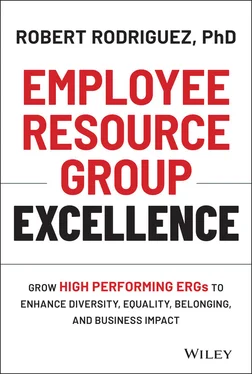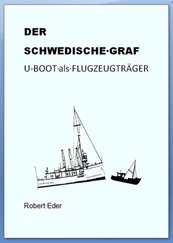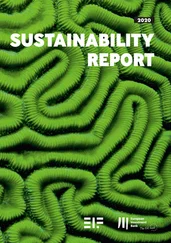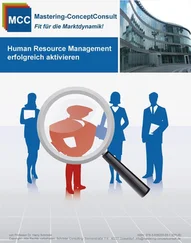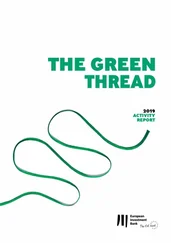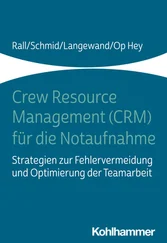To companies: Thanks for all you do to support employee resource groups. May this book help you create the conditions that will nurture ERG excellence.
To ERG members and leaders: This book is dedicated to you, due to your willingness to give back and commit your time and energy above and beyond your day jobs to help run and maintain your employee resource groups. This book is my gift to you for all that ERGs have provided me during my lifetime. I will be forever grateful.
Introduction: The Milli Vanilli Syndrome
My Personal Connection to Employee Resource Groups
The city of Matamoros in Mexico seems like an odd place to point to as the origination point for this book that eventually was destined to be titled Employee Resource Group Excellence . Matamoros is a city in the northeastern Mexican state of Tamaulipas. It is located on the southern bank of the Rio Grande, directly across the border from Brownsville, Texas.
Matamoros is the birthplace of my father, German. My father is the oldest of eight children, all of whom were born and raised in or near Matamoros. When my father reached the age where he could work, he would go across the border to work in Brownsville, Texas. It is in Brownsville that my father eventually met my mother, Janie. Janie is Mexican American, but she is a United States citizen, born in Texas. After a short courtship, German and Janie married and settled in the city of Lubbock, located in the panhandle region of Texas.
Lubbock is the city where I was born in 1969. My memories of Lubbock are rather vague, as we lived there only until I turned four years old. Our family, along with my aunts, uncles, and cousins, used to travel to the Midwest every year as migrant workers. We would go to cities like Traverse City, Michigan, to work the cherry fields and Wahpeton, North Dakota, to help with the sugar beet harvest. We eventually settled on the west side of St. Paul, Minnesota, which is where I grew up and spent my youth during the decades of the 1970s and 1980s.
This upbringing is what led me to eventually join employee resource groups. You see, Minnesota is a great place to live, and was a great place for a child to grow up. However, during my formative years as a child, there was not a large Hispanic population in the Twin Cities, which is what Minneapolis and St. Paul combined are called. Other than my extended Hispanic family that settled in Minnesota with us, there were not many other Latinos. Even today in 2021, the percentage of Hispanics living in Minnesota is still only approximately 5 percent. It was definitely much less back in the 1970s.
My parents, who were well intentioned, encouraged me to connect with the local Anglo kids in the neighborhood. Soon you would find me on the hockey rinks in the winter and baseball fields in the summer. Friends and neighborhood kids to hang out with were not too hard to find, but almost none were Hispanic like me. Additionally, my parents encouraged me to assimilate within the predominantly white community in which we lived. For example, instead of learning to dance Mexican cumbias or rancheras, I learned American dances and the polka – there were lots of polka bands at weddings and parties in Minnesota, I soon realized.
Assimilating and downplaying my Hispanic heritage served me well in high school and even in college. While I was not ashamed of my Hispanic heritage, I wasn't leaning into it nor celebrating it. It simply was not a big part of my identity. My cousins who had remained in Texas and decided not to move to Minnesota were more fluent in Spanish, more knowledgeable about their heritage, and wore their Latino identity on their sleeve. I guess it is easier to celebrate your Hispanic heritage when you are surrounded by a large number of Hispanics.
Anyhow, after finding academic success in high school and in college, it eventually came time to join corporate America and start my professional career. My first two jobs were with large corporations, Target Stores and 3M Company. My jobs with both of these companies were based in Minnesota, so I naturally followed the same routine as when I was in school. That is, I identified as Hispanic, didn't deny it but also did not celebrate it either nor manifest it to a great degree.
Back in the late 1980s and early 1990s, the pop duo group known as Milli Vanilli was hugely popular and successful. The group had several hit songs, including “Girl You Know It's True,” “Blame It on the Rain,” and “Baby Don't Forget My Number,” each reaching the number 1 ranking on the Billboard Hot 100. I even admit to liking the group and their songs.
With their good looks, catchy songs, and appealing videos, Milli Vanilli went on to win a Grammy for Best New Artist in 1990. The two members of Milli Vanilli, Fab Morvan and Rob Pilatus, were adored by fans and loved by the music industry. Unfortunately, it was eventually discovered that while Rob and Fab appeared in the Milli Vanilli music videos and performed at the concerts, it was not their voices that were recorded on the album. Once word got out that other artists supplied the vocals on the album, Milli Vanilli was dropped by their record label, their various awards were taken away, and they were shunned by everyone and ultimately became famous for being fakes and inauthentic.
While the Milli Vanilli scandal played out, my career was progressing nicely. I was performing well in my job and was gaining respect at work, making many new friends and professional colleagues. So well in fact that I was deemed early in my career as someone who had high potential for accelerated career advancement. At the time that I was working at 3M, any young professional who was rated as having high potential had to participate in the company's leadership assessment program. The program consisted of taking a personality indicator (I took the Myers‐Briggs Type Indicator), having one‐on‐one interviews with leadership development experts, completing an inbox work simulation exercise, and participating in a 360‐degree feedback review session where a group of my peers and reporting staff comment on my performance and what I am like to work with.
Overall, my assessment results were strong, and I continued to get promoted about every 18 months or so – I was on the fast track. However, there was one bit of feedback from my 360‐degree review that I will never forget. One of my peers indicated that I came across as inauthentic because it appeared to them that I was downplaying or hiding certain aspects of myself so as not to appear different, and that I was disassociating from one of the dimensions of my identity. This peer knew that I was Hispanic, but since I wasn't really embracing my Hispanic heritage at work, to him I came across as being inauthentic: “He sort of reminds me of Milli Vanilli because he makes me think he is faking something, and I'm not sure I can trust someone who is faking.”
Ouch. This comment stung. Still stings to this day. I had never felt like I was being a phony at work. I never claimed to be someone I was not. But apparently, to this one other person, that is exactly how I was coming across. The leadership development expert who was assigned to review my results told me that because my results were so strong, I shouldn't worry too much about this one single comment. She reminded me that every bit of feedback is a gift if it helps a person improve or raise their awareness. I was happy with the results of the assessment, but the Milli Vanilli comment stuck with me for many years. Little did I know, however, that this would initiate my eventual employee resource group involvement.
After several short job assignments in various small towns in the Midwest in which 3M had manufacturing facilities, eventually my career required a relocation to Chicago. Of course, I was excited that I was going to a big metropolitan area. Little did I know at the time that this move would be the start of my journey to become more connected with my Hispanic heritage, and it is what led me to seek out and join employee resource groups. This happened in part because several things changed upon arriving in Chicago and connecting more closely with my Hispanic heritage.
Читать дальше
